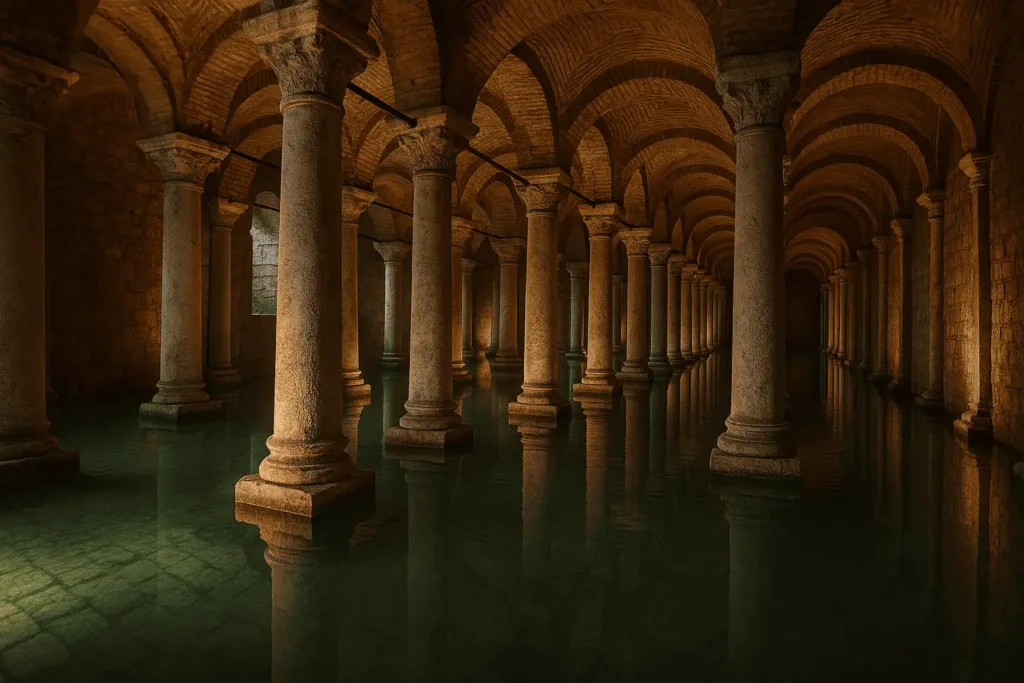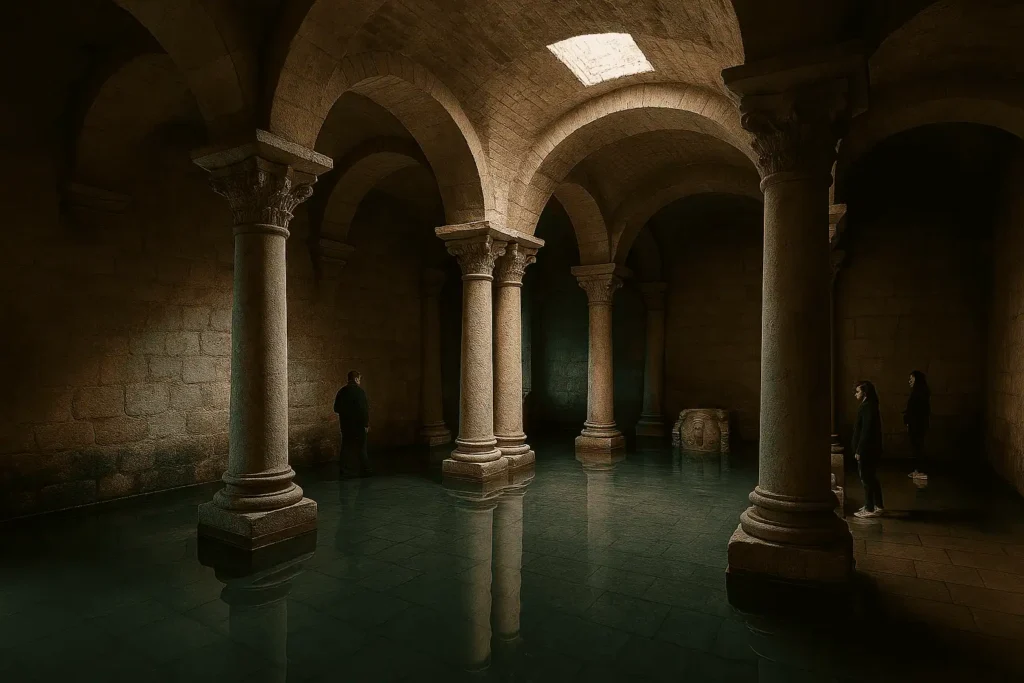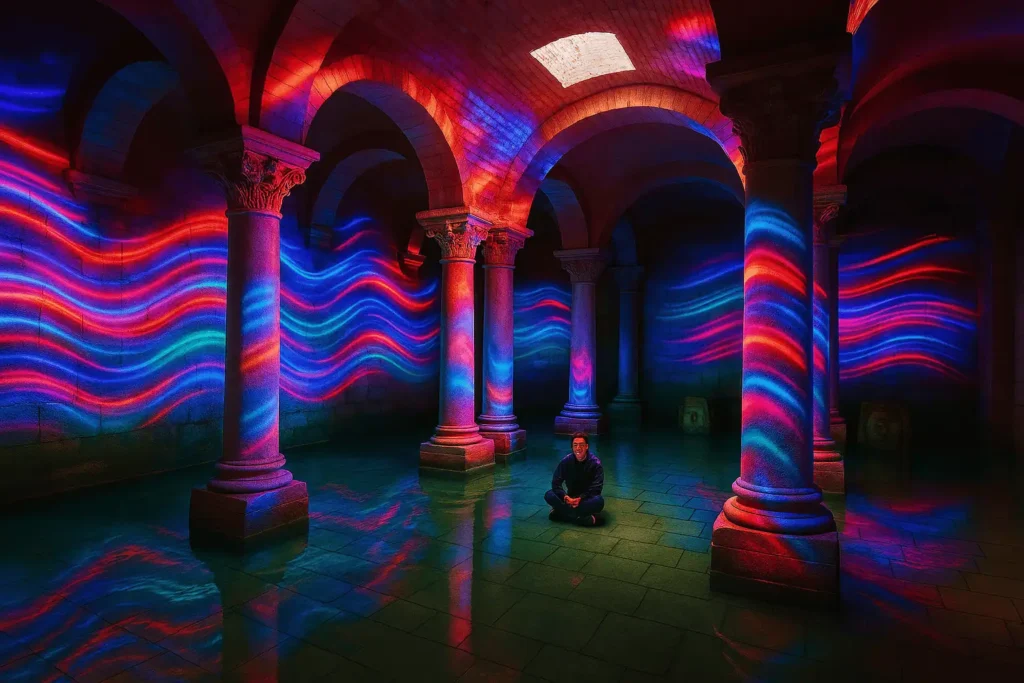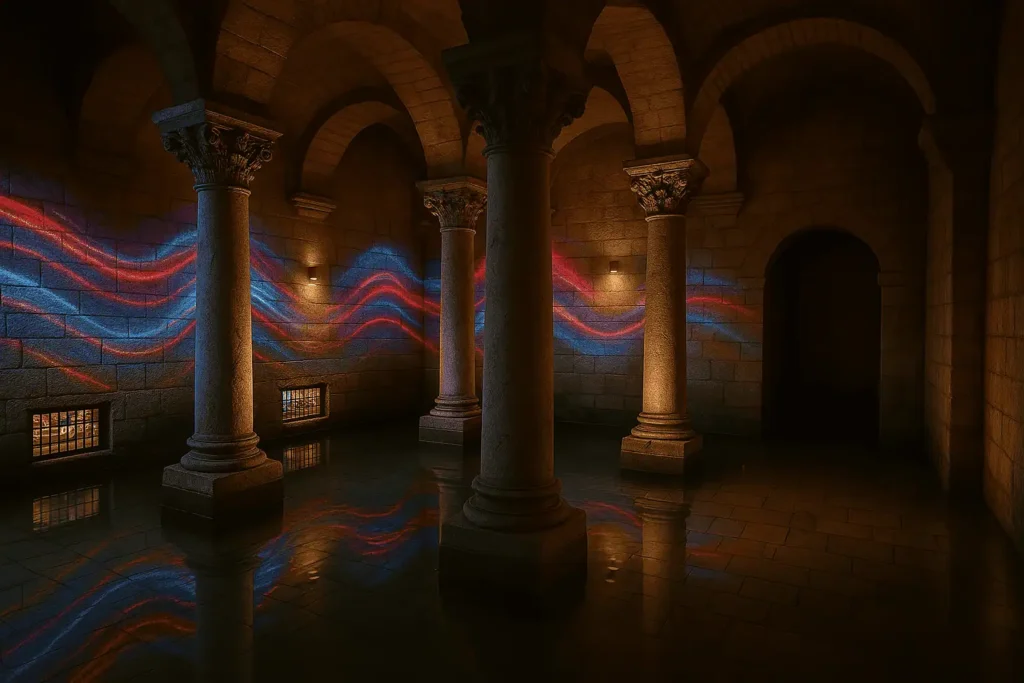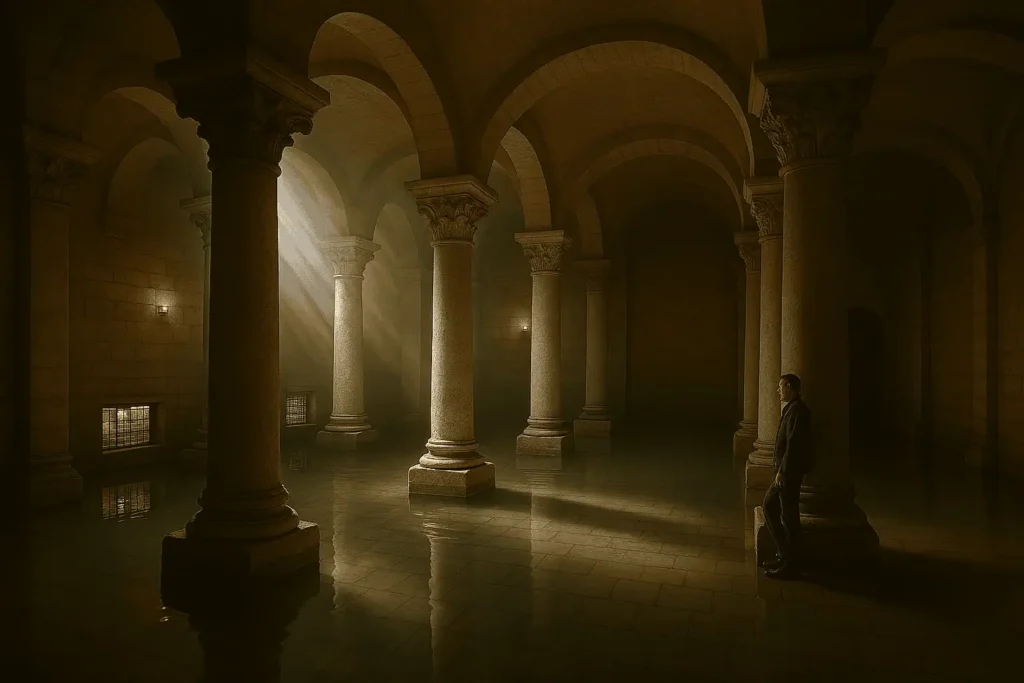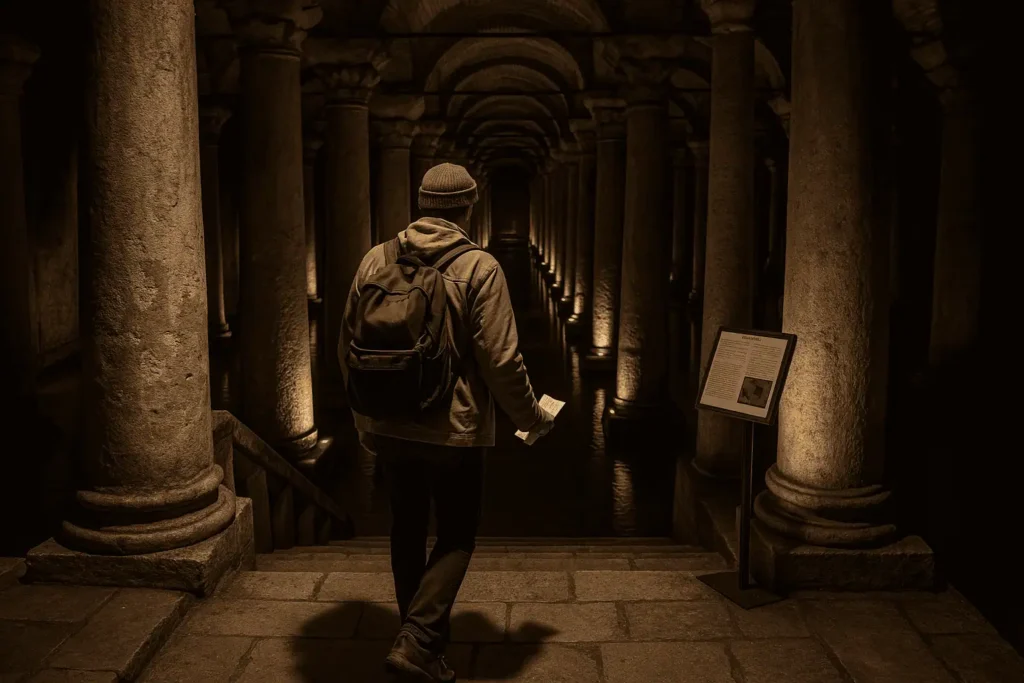I was standing in the middle of Sultanahmet, feet aching, dodging tour groups near Hagia Sophia. That’s when I saw the quiet entrance to a forgotten underground world—a stone staircase leading somewhere dark and cool. Out of curiosity, I followed it. What I found wasn’t just a tourist stop; it was a living piece of Istanbul’s hidden history.
Beneath the busy streets of this ancient city lies a vast network of Byzantine cisterns in Istanbul, silent witnesses to over a thousand years of empire, architecture, and survival. These underground water reservoirs once kept the city alive—storing and supplying fresh water to its residents, palaces, and bathhouses.
While the Basilica Cistern is the most popular of them all, it’s far from the only one. In fact, some of the most beautiful and historically rich cisterns remain tucked away from the tourist crowds—quiet, mystical, and often completely overlooked. If you’re the kind of traveler who wants to step off the beaten path and into something authentic, you’re in the right place.
What Are Byzantine Cisterns and Why Were They Built?
Long before modern plumbing, the people of Constantinople—what we now call Istanbul—relied on a vast underground system to store and distribute water. These were the Byzantine cisterns in Istanbul, massive stone reservoirs built beneath the city to collect and hold rainwater and aqueduct-fed supplies.
Constructed with remarkable engineering precision, many of these cisterns were built during the reign of Emperor Justinian I in the 6th century. His rule marked one of the most ambitious infrastructure booms in Byzantine history, and water was at the heart of it. Cisterns were created not only to meet the needs of the growing population but also to prepare the city for sieges, droughts, or disruptions to the aqueducts that flowed in from Thrace.
These underground chambers, often supported by rows of majestic marble columns, became a vital part of the city’s life. They were quiet, dark, and cool—and entirely out of sight. In many ways, the cisterns acted like the veins of old Constantinople, silently circulating life beneath the surface, keeping the palaces, churches, and baths functioning even during the harshest times.
Today, a few of these ancient cisterns are open to the public, offering a glimpse into the ingenuity of a civilization that understood how to build not just upward—but downward, deep into the earth.
The Basilica Cistern: The Icon Everyone Knows
If you’ve done even the slightest bit of research about Istanbul, you’ve probably heard of the Basilica Cistern. It’s easily the most famous of all the Byzantine cisterns in Istanbul—and for good reason.
Built during the 6th century under Emperor Justinian, the Basilica Cistern is an architectural marvel hidden beneath the heart of the city. With over 330 marble columns rising from shallow water, dim lighting that creates a mysterious atmosphere, and the soft sound of dripping water echoing through the space, the experience feels like stepping into a hidden world frozen in time.
But what really captures the imagination of visitors are the two massive Medusa heads used as column bases at the back of the cistern. Their origin is still debated, but their eerie presence gives the site a mythological touch that fascinates everyone who visits.
It’s no surprise that tourists flock here in large numbers. It’s cinematic, historical, and undeniably beautiful. But here’s the thing—
What if I told you the real gems are the ones you’ve never heard of?
Beyond the crowds and camera flashes lies a network of quieter, lesser-known cisterns—places just as rich in history, but far more peaceful. These are the underground secrets where you can truly feel the pulse of ancient Constantinople.
Theodosius Cistern: A Hidden Treasure Beneath the Streets
Just a short walk—less than ten minutes—from the bustling Basilica Cistern, near the Şerefiye area, lies the Theodosius Cistern. Unlike its famous neighbor, this underground marvel remains a quiet refuge, often overlooked by the typical tourist route.
Theodosius Cistern is smaller in size but no less impressive. One of its standout features is a beautifully restored roof that lets in just enough natural light to create a gentle, calming glow. Soft lighting enhances the ancient columns and peaceful water pools, making it feel like a secret sanctuary beneath Istanbul’s busy streets.
When you compare Theodosius Cistern vs Basilica Cistern, the differences are striking. While Basilica is grand and dramatic, filled with crowds and echoing sounds, Theodosius offers a more intimate experience. The atmosphere here is calm and reflective, with far fewer visitors, which means you can hear the subtle drip of water and your own footsteps—something that’s rare in the crowded Basilica.
Many travelers who seek authenticity and tranquility prefer Theodosius. It’s a place to slow down, breathe, and imagine what life might have been like in Byzantine times without the distractions of large tour groups.
Şerefiye Cistern: Ancient Walls with Modern Art
If you think Byzantine cisterns are just old, damp spaces, the Şerefiye Cistern will change your mind. This remarkable site is a stunning fusion of ancient history and cutting-edge technology. Located near the Grand Bazaar, it’s one of the lesser-known cisterns you can visit in Istanbul that brings the past to life in an entirely new way.
Inside Şerefiye, the old stone walls and towering columns become a canvas for vibrant light shows. Digital waves and colors dance across surfaces that are older than most countries today, creating an atmosphere that is both mesmerizing and deeply moving. It’s a sensory experience that connects you with the ancient Byzantine water system through a modern lens.
For visitors, Şerefiye Cistern is open most days with affordable entry fees—perfect for anyone looking to escape the usual crowds. Photography is encouraged, and the interplay of light and shadow makes for incredible shots, especially if you arrive when the lights are just starting their show.
I still remember sitting quietly in the middle of the room while digital waves danced across columns older than most countries. It felt like time had folded in on itself—a place where history and art meet underground.
Other Hidden Byzantine Cisterns Worth Visiting
Beyond the more famous sites like Basilica, Theodosius, and Şerefiye, Istanbul holds several hidden cisterns that few travelers get to explore. These lesser-known treasures offer an authentic glimpse into the city’s Byzantine past, often tucked away beneath everyday buildings.
One such site is the Philoxenos Cistern, also known as Binbirdirek, meaning “a thousand and one columns.” Located near the Hippodrome, it’s larger than Theodosius but much quieter than Basilica. Its vast hall of slender columns creates a surreal atmosphere perfect for those who want to feel the weight of history without the crowds.
Another fascinating spot is the cistern near the Nuruosmaniye Mosque, just steps from the Grand Bazaar. This cistern is small and easily missed but worth seeking out if you’re curious about the city’s hidden layers.
A useful tip: many of these cisterns are hidden beneath hotels, restaurants, or shops, and sometimes only marked by small, discreet signs. Don’t hesitate to ask local shopkeepers or guides—they often know these secret entrances and can point you in the right direction.
For those eager to uncover hidden cisterns in Istanbul, these spots are perfect off-the-beaten-path adventures that combine history, mystery, and quiet beauty.
Why These Forgotten Spaces Matter
In a city as bustling and crowded as Istanbul, finding a moment of quiet can feel like a rare gift. These forgotten Byzantine cisterns offer exactly that—a peaceful escape beneath the noise of modern life. The beauty of silence and open space underground allows visitors to connect with history in a deeply personal way.
Beyond their calm atmosphere, these cisterns play a crucial role in preserving forgotten Byzantine architecture. The stone columns, arches, and water channels are living artifacts, showcasing the ingenuity and craftsmanship of a civilization long past. Walking through them, you can almost hear the echoes of an ancient city thriving above.
What makes these spaces even more remarkable is their spiritual quality. Though they were never built as religious sites, the cool darkness, still waters, and solemn silence give them a meditative aura. Visitors often describe a sense of wonder and reverence, as if stepping into a secret sanctuary carved by time itself.
For travelers who crave something different from typical tourist stops, exploring these hidden cisterns offers an offbeat experience full of mystery, history, and quiet beauty. It’s a chance to uncover Istanbul’s layers beyond the obvious—to see the city from a whole new angle.
Practical Tips for Visiting Byzantine Cisterns in Istanbul
When planning your visit to Istanbul’s incredible Byzantine cisterns, a little preparation can go a long way in making your experience smooth and enjoyable.
Entry Information:
Most cisterns are open to the public, with access managed either through ticket counters or online booking systems. It’s best to check official websites or ask at nearby tourism info centers for the most current details on entry and hours.
Best Times to Visit:
To avoid crowds and fully appreciate the peaceful atmosphere, aim for early mornings or weekdays. Popular spots like the Basilica Cistern can get busy by mid-morning, especially in high season.
What to Wear:
Cisterns remain naturally cool and slightly humid underground, even in summer. Comfortable footwear and a light jacket or layer are recommended—especially if you plan to visit multiple sites in one day.
Accessibility Notes:
While some major cisterns have improved access with elevators or ramps, others still require descending steep or uneven stairs. If accessibility is a concern, research specific sites ahead of time or consider joining a guided tour with local insight.
With these tips in mind, your underground adventure through Istanbul’s Byzantine cisterns will be both memorable and comfortable.
Conclusion: Underground Istanbul Is Waiting
The Byzantine cisterns in Istanbul are more than just ancient reservoirs—they are gateways to a hidden world where history, art, and engineering collide beneath the city’s vibrant surface. From majestic columns rising from shimmering waters to quiet, contemplative spaces away from the tourist crowds, these underground marvels offer peaceful moments and stunning visuals unlike anywhere else.
Next time you’re in Istanbul, skip the queues and the usual crowded spots. Step underground—you’ll feel the heartbeat of a thousand-year-old city pulsing through the stones and shadows. It’s an experience that stays with you long after you emerge back into the sunlight.
Discover the secrets below—your journey into Istanbul’s hidden past awaits.
💡 Bonus Tip:
📍 Planning your trip? Our local guides can help you uncover these secret spots without the hassle. Book a private experience with someone who knows the underground maze inside and out—making your visit seamless, insightful, and unforgettable.

